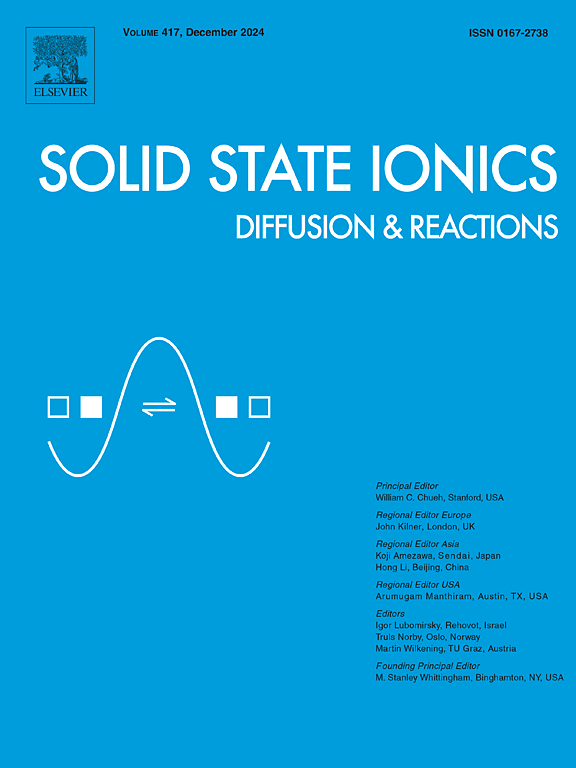以CaSnO3-ZnO异质结构为电解质提高中温固体氧化物燃料电池性能
IF 3
4区 材料科学
Q3 CHEMISTRY, PHYSICAL
引用次数: 0
摘要
新型异质结构电解质的发展和固体氧化物燃料电池(SOFC)性能的提高是发展中温固体氧化物燃料电池(SOFC)的一个有前途的策略。本研究主要通过溶胶-凝胶技术合成CaSnO3,并制备CaSnO3- zno复合材料作为中温sofc的电解质。在550°C时,2Ca8Zn复合材料的离子电导率为0.204 S cm−1,峰值功率密度为700 mW cm−2,在相同的热条件下,间歇性耐用性长达24 h。通过对能带结构的进一步研究,发现CaSnO3-ZnO复合材料是中温sofc电解质的理想候选材料。研究结果表明,氧化钙和氧化锌的结合可以在材料内部形成n-n异质结,通过产生空间电荷区来增强离子电导率,同时抑制电子电导率。因此,CaSnO3-ZnO纳米复合材料有望为中温固体氧化物燃料电池的发展铺平道路。本文章由计算机程序翻译,如有差异,请以英文原文为准。

Enhanced performance of medium-temperature solid oxide fuel cells using CaSnO3-ZnO heterostructure as electrolyte
The advancement of novel heterostructure electrolytes and the enhancement of solid oxide fuel cell (SOFC) performance represent a promising strategy for developing medium-temperature SOFCs. This study focuses on synthesizing CaSnO3 via the sol-gel technique and fabricating CaSnO3-ZnO composites to serve as electrolytes for medium-temperature SOFCs. At 550 °C, the 2Ca![]() 8Zn composite demonstrated an ionic conductivity of 0.204 S cm−1, a peak power density of 700 mW cm−2, and intermittent durability lasting up to 24 h under identical thermal conditions. Upon further investigation of the energy band structure, it has been revealed that CaSnO3-ZnO composites are promising candidates for serving as electrolytes in medium-temperature SOFCs. The findings indicate that the combination of calcium and zinc oxides can form n-n heterojunctions within the material, which enhance ionic conductivity by creating space charge regions, while simultaneously suppressing electronic conductivity. Consequently, CaSnO3-ZnO nanocomposites are anticipated to pave the way for advancements in intermediate-temperature solid oxide fuel cells.
8Zn composite demonstrated an ionic conductivity of 0.204 S cm−1, a peak power density of 700 mW cm−2, and intermittent durability lasting up to 24 h under identical thermal conditions. Upon further investigation of the energy band structure, it has been revealed that CaSnO3-ZnO composites are promising candidates for serving as electrolytes in medium-temperature SOFCs. The findings indicate that the combination of calcium and zinc oxides can form n-n heterojunctions within the material, which enhance ionic conductivity by creating space charge regions, while simultaneously suppressing electronic conductivity. Consequently, CaSnO3-ZnO nanocomposites are anticipated to pave the way for advancements in intermediate-temperature solid oxide fuel cells.
求助全文
通过发布文献求助,成功后即可免费获取论文全文。
去求助
来源期刊

Solid State Ionics
物理-物理:凝聚态物理
CiteScore
6.10
自引率
3.10%
发文量
152
审稿时长
58 days
期刊介绍:
This interdisciplinary journal is devoted to the physics, chemistry and materials science of diffusion, mass transport, and reactivity of solids. The major part of each issue is devoted to articles on:
(i) physics and chemistry of defects in solids;
(ii) reactions in and on solids, e.g. intercalation, corrosion, oxidation, sintering;
(iii) ion transport measurements, mechanisms and theory;
(iv) solid state electrochemistry;
(v) ionically-electronically mixed conducting solids.
Related technological applications are also included, provided their characteristics are interpreted in terms of the basic solid state properties.
Review papers and relevant symposium proceedings are welcome.
 求助内容:
求助内容: 应助结果提醒方式:
应助结果提醒方式:


